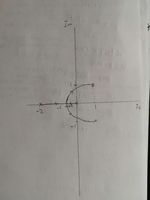| (7 intermediate revisions by the same user not shown) | |||
| Line 1: | Line 1: | ||
[[Category:ECE]] | [[Category:ECE]] | ||
[[Category:QE]] | [[Category:QE]] | ||
| − | + | ||
| − | + | ||
| − | + | ||
<center> | <center> | ||
| Line 72: | Line 70: | ||
when <math>K=1</math>, for <math>s^2</math> row, <math>2s^2+2 = 0 \Rightarrow \omega_n = 1</math> | when <math>K=1</math>, for <math>s^2</math> row, <math>2s^2+2 = 0 \Rightarrow \omega_n = 1</math> | ||
| + | |||
==Problem 4== | ==Problem 4== | ||
| + | A) <math>\angle G(s)_{|s=-2+j2\sqrt{3}} = \frac{2}{(-2+j2\sqrt{3})(-1+j2\sqrt{3})} = -(180^{\circ}-tan^{-1}(\frac{2\sqrt{3}}{2}))-(180^{\circ}-tan^{-1}(2\sqrt{3})) = 60^{\circ}+73.9^{\circ}-360^{\circ} = -226.1^{\circ}</math> | ||
| + | |||
| + | <math>\phi = 46.1^{\circ}</math> | ||
| + | |||
| + | B) <math> K_v^{G} = \lim_{s\rightarrow 0}sG(s) = 2 </math> | ||
| + | |||
| + | <math> \alpha_2 = \frac{K_v^{G_d}}{K_v^{G}} = \frac{20}{2} = 10 </math> | ||
| + | |||
| + | 10% rule: zeros location: <math>\frac{-1}{\tau_2} = -0.1</math> and poles location: <math>\frac{-1}{\alpha_2\tau_2} = -0.01</math> | ||
| + | |||
| + | PI portion <math>G_c = \frac{s+0.01}{s+0.1} </math> | ||
| + | |||
| + | C) <math>\phi = 46.1^{\circ} + 3^{\circ} = 49.1^{\circ}</math> | ||
| + | |||
| + | <math>\theta = cos^{-1}(0.5) = 60^{\circ}</math> | ||
| + | |||
| + | zero location: <math>\frac{1}{\tau} = \frac{\omega_n cos(\frac{\theta+\phi}{2})}{\frac{cos(\theta-\phi)}{2}} = \frac{4cos(\frac{109.1^{\circ}}{2})}{cos(\frac{10.9}{2})} = 2.3032</math> | ||
| + | |||
| + | pole location: <math>\frac{1}{\alpha\tau} = \frac{\omega_n \frac{cos(\theta-\phi)}{2}}{cos(\frac{\theta+\phi}{2})} = \frac{4cos(\frac{10.9}{2})}{cos(\frac{109.1^{\circ}}{2})} = 6.9470</math> | ||
| + | |||
| + | <math>G_c(s) = \frac{(s+2.3032)(s+0.01)}{(s+6.9470)(s+0.1)}</math> | ||
Latest revision as of 23:16, 1 August 2019
Automatic Control (AC)
Question 1: Feedback Control Systems
August 2017 (Published in Jul 2019)
Contents
Problem 1
A) $ \frac{C(s)}{R(s)} = \frac{4}{s(s+1)} $
B) $ \frac{B(s)}{E(s)} = \frac{2}{s+1}+\frac{4}{s(s+1)} = \frac{2s+4}{s(s+1)} $
C) $ \frac{C(s)}{R(s)} = \frac{\frac{4}{s(s+1)}}{1+\frac{2s+4}{s(s+1)}} $
D) $ 1+\frac{2s+4}{s(s+1)} = 0 $
E) $ s(s+1)+2s+4 = 0 \Rightarrow s^2+3s+4=0 $
$ \therefore \omega_n^2 =4, \; 2\zeta \omega_n = 3 \Rightarrow \tau = \frac{1}{\zeta \omega_n} = \frac{3}{2} $
F) $ \frac{3}{4} $
G) since $ \zeta > 0 \therefore \omega_n = 2 $
H) two poles, type 2
I) $ \ddot{y}(t)+\dot{y}(t) = 4u(t) $
Problem 2
$ k_p = \lim_{s\rightarrow 0} G(s) = \infty $
$ k_v = \lim_{s\rightarrow 0} sG(s) = \frac{K}{6} $
$ e_ss = \lim_{s\rightarrow 0}sE(s) = \lim_{s\rightarrow 0} \frac{sR(s)}{1+G(s)} = \frac{1}{1+\lim_{s\rightarrow 0}G(s)} + \frac{1}{\lim_{s\rightarrow 0}sG(s)} = \frac{1}{1+k_p} + \frac{1}{k_v} = 0.2 $ $ \therefore K = 30 $
Problem 3
B) Two complex conjugate zeros:
arrival angle of zero 1+j:
angle to zeros: $ (1+j) - (1-j) = 90^{\circ} $
angle to poles: $ (1+j) - 0 = 45^{\circ} $
$ (1+j) - (-2) = 3+j = 18.43^{\circ} $
Arrival angle of 1+j: $ 180^{\circ} + 45^{\circ} + 18.43^{\circ} - 90^{\circ} = 153.43^{\circ} $
similar for 1-j: $ 180^{\circ} - 45^{\circ} - 18.43^{\circ} + 90^{\circ} = -153.43^{\circ} $
C) $ s^2 \; K+1 \;\;\;\;\; 2K $
$ s^1 \; 2-2K $
$ s^0 \; -2K $
set $ 2-2K = 0 \Rightarrow K =1 $, so system stable at $ 0<K<1 $
when $ K=1 $, for $ s^2 $ row, $ 2s^2+2 = 0 \Rightarrow \omega_n = 1 $
Problem 4
A) $ \angle G(s)_{|s=-2+j2\sqrt{3}} = \frac{2}{(-2+j2\sqrt{3})(-1+j2\sqrt{3})} = -(180^{\circ}-tan^{-1}(\frac{2\sqrt{3}}{2}))-(180^{\circ}-tan^{-1}(2\sqrt{3})) = 60^{\circ}+73.9^{\circ}-360^{\circ} = -226.1^{\circ} $
$ \phi = 46.1^{\circ} $
B) $ K_v^{G} = \lim_{s\rightarrow 0}sG(s) = 2 $
$ \alpha_2 = \frac{K_v^{G_d}}{K_v^{G}} = \frac{20}{2} = 10 $
10% rule: zeros location: $ \frac{-1}{\tau_2} = -0.1 $ and poles location: $ \frac{-1}{\alpha_2\tau_2} = -0.01 $
PI portion $ G_c = \frac{s+0.01}{s+0.1} $
C) $ \phi = 46.1^{\circ} + 3^{\circ} = 49.1^{\circ} $
$ \theta = cos^{-1}(0.5) = 60^{\circ} $
zero location: $ \frac{1}{\tau} = \frac{\omega_n cos(\frac{\theta+\phi}{2})}{\frac{cos(\theta-\phi)}{2}} = \frac{4cos(\frac{109.1^{\circ}}{2})}{cos(\frac{10.9}{2})} = 2.3032 $
pole location: $ \frac{1}{\alpha\tau} = \frac{\omega_n \frac{cos(\theta-\phi)}{2}}{cos(\frac{\theta+\phi}{2})} = \frac{4cos(\frac{10.9}{2})}{cos(\frac{109.1^{\circ}}{2})} = 6.9470 $
$ G_c(s) = \frac{(s+2.3032)(s+0.01)}{(s+6.9470)(s+0.1)} $


